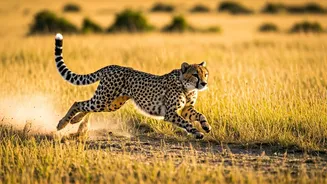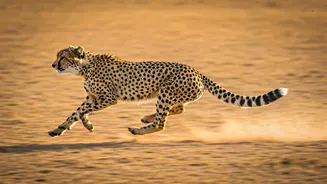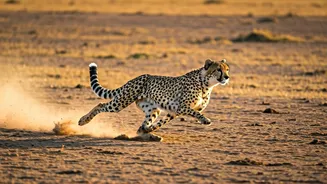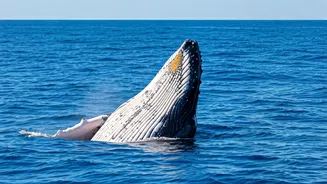Swift Cheetah's Sprint
The cheetah, a symbol of speed, holds the title as the fastest land animal. Known for its incredible bursts of speed, a cheetah can reach up to 75 mph
(120 km/h) in mere seconds. This astonishing velocity is thanks to its streamlined body, flexible spine, and large heart and lungs, which allow for efficient oxygen intake. Cheetahs typically live in open grasslands and savannas, where their speed helps them hunt prey, such as gazelles and antelopes. Their speed is not just a matter of athleticism; it is also a vital adaptation for survival, allowing them to catch their meals and evade predators.
Peregrine Falcon's Dive
The peregrine falcon, a bird of prey, earns its reputation for being the fastest animal in the world, particularly when diving. These falcons can reach speeds of over 200 mph (320 km/h) during their stoop, a hunting technique where they dive from great heights to catch their prey. This extreme speed is achieved through their aerodynamic body shape and the ability to control their descent. Peregrine falcons are found on every continent except Antarctica, nesting on cliffs and buildings. Their aerial prowess and swift movements have made them a symbol of grace and power.
Sailfish's Ocean Race
In the ocean depths, the sailfish takes the lead as one of the swiftest swimmers. These impressive creatures can reach speeds of up to 68 mph (110 km/h). Their name comes from their large dorsal fin, which resembles a sail. Sailfish use this fin for balance and to herd prey. Found in warm waters worldwide, sailfish are known for their sleek bodies and powerful swimming abilities, allowing them to navigate the ocean with remarkable speed and agility. Their speed helps them chase fast-moving fish and escape predators.
Pronghorn's Prairie Run
The pronghorn, native to North America, is another exceptionally fast land animal, often compared to the cheetah. Pronghorns can reach speeds of up to 55 mph (88 km/h). They have evolved to live in open plains and grasslands, where their speed helps them evade predators like coyotes and wolves. Pronghorns possess large lungs, a specialized trachea, and a lightweight body, enabling them to sustain high speeds over long distances. Their endurance makes them well-suited for surviving in the vast landscapes of the American West.
Frigatebird's Aerial Flight
The frigatebird, a seabird, is a master of aerial speed, often spending days in flight. These birds are known for their agility and can reach speeds of up to 95 mph (153 km/h). With their long, pointed wings and forked tails, frigatebirds are highly maneuverable in the air. They are skilled at soaring, gliding, and swooping to catch fish and other prey from the ocean's surface. Found in tropical and subtropical regions, frigatebirds showcase the adaptation of speed for both hunting and navigation across large expanses of water.
Black Marlin's Deep Dive
The black marlin is an exceptionally fast fish that lives in the ocean, celebrated for its speed and power. These marlins can reach speeds of up to 80 mph (129 km/h). They possess a streamlined body and a powerful tail, which allows them to cut through the water efficiently. Found in tropical and subtropical waters, black marlins are known for their impressive size and the spectacular jumps they make when hooked by anglers. Their speed is an advantage for catching fast-moving prey and for evading potential dangers.
Marlin's Aquatic Power
Another fast fish, the striped marlin, also showcases impressive speed in the water. They can reach speeds of up to 50 mph (80 km/h). The streamlined bodies and powerful tails of these marlins enable them to move quickly through the ocean. They typically feed on fish and squid. Often found in the Pacific and Indian Oceans, these marlins are renowned for their aggressive hunting style and agility in the water, adding to the variety of speedy species in the marine environment.









